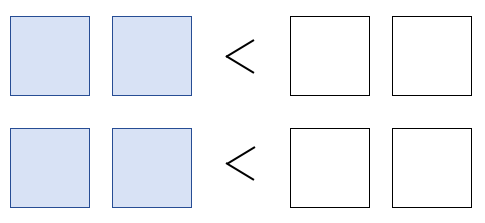Or search by topic
Number and algebra
Geometry and measure
Probability and statistics
Working mathematically
Advanced mathematics
For younger learners
Less Is More



This is a game for two people, but is better played in two teams of two.
You will need a 1-6 or 0-9 dice. The interactivity can be used to simulate throwing different dice.
Each team should draw some cells that look like the picture below. (The cells on the left don't need to be a different colour, but we will refer to those cells later.) Alternatively, you could print off this sheet of cells.

Version 1
You will need to throw the dice eight times in total. After each throw of the dice, each team decides which of their cells to place that number in.
When all the cells are full, each team will have created four two-digit numbers.
Teams then check if their number sentences are correct:
- If both number sentences are correct, the team scores the sum of the two two-digit numbers written in the blue boxes.
- If only the first number sentence is correct, the team scores the two-digit number in the top blue boxes.
- If only the second number sentence is correct, the team scores the two-digit number in the bottom blue boxes.
The winner is the team with higher score. See the hint for some examples of scoring.
Have a go at playing the game and keep a running total of your scores.
- Who is the winner after ten rounds?
- Who is the first to reach 500 points?
In between rounds, teams might like to find the highest possible score they could have achieved, if they had known the eight numbers in advance. These scores can be added to their running totals.
Will this affect your strategy in the next round?
Version 2
Now, imagine that the numbers 1, 2, 3, 4, 5, 6, 7 and 8 have been thrown.
Where would you place them in order to get the highest possible score?
Can you provide a convincing argument that you have arranged the numbers in the best possible way?
Have a go at playing the game just as you did in Version 1, but this time note down all eight dice rolls before deciding where to place them.
You can score in the same way as you did in Version 1. This time it could be the first to reach 1000 points who wins!
An interesting follow-up to this game is More Less is More, which again challenges you to create correct statements, but this time after carrying out some simple calculations.
This activity featured in an NRICH student webinar in November 2022.
You may also like
Six Is the Sum
What do the digits in the number fifteen add up to? How many other numbers have digits with the same total but no zeros?
ABC
In the multiplication calculation, some of the digits have been replaced by letters and others by asterisks. Can you reconstruct the original multiplication?

